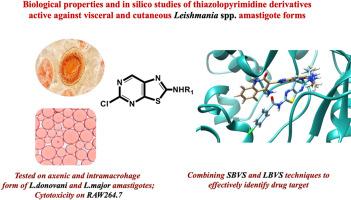Biological properties and in silico studies of thiazolopyrimidine derivatives active against visceral and cutaneous Leishmania spp. amastigote forms
European Journal of Medicinal Chemistry Reports
Pub Date : 2024-10-08
DOI:10.1016/j.ejmcr.2024.100228
引用次数: 0
Abstract
Visceral leishmaniasis, the most severe form of the disease, is caused by L. donovani and L. infantum parasites; cutaneous leishmaniasis is the most common endemic form of leishmaniasis and mainly caused by L. tropica and L. major. We have previously described a series of thiazolopyrimidine derivatives and reported their antipromastigote activities against various parasites. In this study, we also investigated their activities against L. donovani and L. major axenic amastigotes, intramacrophage amastigotes and cytotoxicity on macrophages to assess selectivity. As a result, five of the compounds tested showed no cytotoxicity on the macrophage cell line; their anti-amastigote activity was close to the positive control, miltefosine. These results confirm the antileishmanial activity of the thiazolopyrimidine scaffold and demonstrate that this may be a starting point for the generation of new lead compounds for treating visceral leishmaniasis and cutaneous leishmaniasis. To elucidate the mechanism of action, we also performed several ligand- and structure-based in silico studies.

噻唑并嘧啶衍生物对内脏和皮肤利什曼原虫非主形态的生物特性和硅学研究
内脏利什曼病是最严重的利什曼病,由唐诺瓦尼氏菌和婴儿利什曼病寄生虫引起;皮肤利什曼病是最常见的地方性利什曼病,主要由热带利什曼病和主要利什曼病寄生虫引起。我们以前曾描述过一系列噻唑并嘧啶衍生物,并报道了它们对各种寄生虫的抗原体活性。在这项研究中,我们还研究了它们对唐诺沃尼氏原虫和大原虫腋生母细胞、巨噬细胞内母细胞的活性以及对巨噬细胞的细胞毒性,以评估其选择性。结果表明,所测试的化合物中有五种对巨噬细胞系没有细胞毒性;其抗母细胞活性接近阳性对照米替福新。这些结果证实了噻唑并嘧啶支架的抗利什曼病活性,并表明这可能是产生治疗内脏利什曼病和皮肤利什曼病的新先导化合物的起点。为了阐明其作用机制,我们还进行了几项配体和结构方面的硅学研究。
本文章由计算机程序翻译,如有差异,请以英文原文为准。
求助全文
约1分钟内获得全文
求助全文

 求助内容:
求助内容: 应助结果提醒方式:
应助结果提醒方式:


